Key takeaways:
- To quickly implement AI chatbots into their operations, businesses often consider ready solutions.
- Off-the-shelf chatbots pose risks for businesses that handle sensitive data or have to meet strict regulatory requirements.
- Custom chatbots offer more flexibility in terms of functionality, data privacy, and compliance.
- To be accurate, a chatbot has to be trained on a large volume of high-quality, structured data.
- Due to its complexity, custom AI chatbot development takes between two and eight months on average.
Chatbots help businesses enhance operational efficiency, improve the user experience, and reduce customer support costs. But to access these benefits, a business needs to invest in its own AI chatbot.
The market offers many AI models, such as GPT-4, Claude, and LLaMA, that can serve as a foundation for business chatbots. However, using these models as is — or with only minor training and fine-tuning — can lead to security risks, regulatory challenges, and limited accuracy.
Off-the-shelf models may struggle to fully align with your business needs, industry terminology, or compliance requirements. This can be especially critical for companies that handle sensitive data or require highly precise answers.
In this article, we break down how to create a custom AI chatbot, from the features and technologies involved to the time, expertise, and investment required. You’ll gain a clear understanding of why developing a custom chatbot is more complex than simply integrating a pre-built model — and how it ultimately leads to a more secure, accurate, and tailored chatbot.
This article will be useful for business leaders who want to understand the process of building a custom chatbot and the factors that may affect estimates and budgets for such a project.
Three main ways to get a chatbot for your business
The primary goal of a chatbot is to automate processes in order to cut the costs of customer support and business operations or to enhance the user experience by giving customers the information they need fast. What chatbot and which approach to take to getting one are different things.
There are three main approaches to getting an AI chatbot:
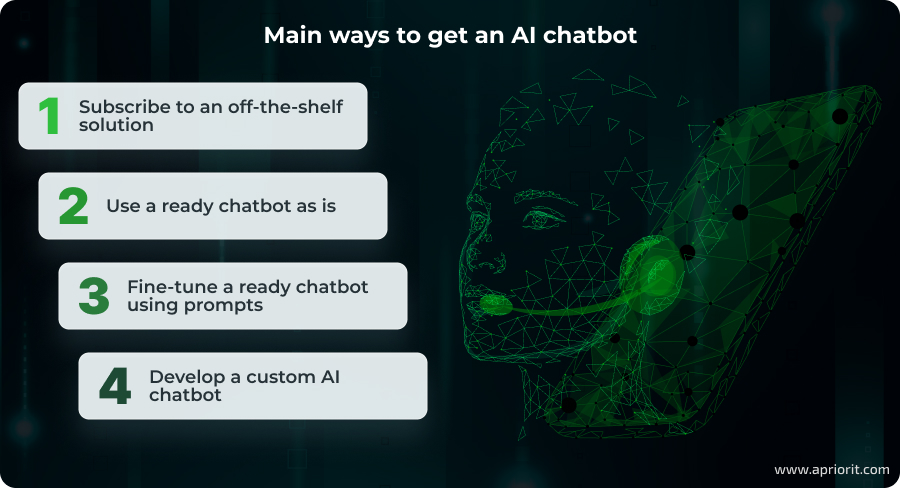
1. Off-the-shelf chatbot solutions
These are ready-to-use third-party chatbots offered as subscription services, such as industry-specific AI assistants or customer support bots. They are pre-built and fine-tuned for general business use cases, allowing companies to quickly deploy AI-driven conversations with minimal effort. Usually, these chatbots are only good at handling very specific tasks and offer limited customization options beyond basic settings.
Third-party chatbots process and store user data on third-party servers, and they may use this data to train their models if it’s not explicitly stated otherwise in the service agreement.
One example of an off-the-shelf chatbot is GPT for Business. You can pay a subscription fee and integrate this chatbot into your solution without any modifications.
2. Prompt-based chatbots
If you require a bit more control and customization than what you get with off-the-shelf chatbots, your next option is usually a prompt-based chatbot. You can access such a chatbot either through an API or by using the chatbot’s platform directly. Then, you will add predefined prompts with instructions to shape the off-the-shelf chatbot’s behavior and optimize responses for specific use cases.
OpenAI provides the most popular prompt-based chatbot services:
- GPT API. With this API, you can access GPT-4 and other models for building AI-powered applications. GPT API operates on a pay-per-use model, where the final cost depends on the number of tokens processed during interactions.
- GPT for Business. Although we mentioned this in the previous off-the-shelf category, GPT for Business also allows you to fine-tune your chatbot through detailed prompts. With them, you can modify the chatbot’s behavior and change parameters like tone of voice, response style, level of formality, and depth of explanations.
In both cases, your chatbot will operate on third-party infrastructure, meaning that user data is processed and may be stored externally.
3. Custom AI chatbots
A custom chatbot is built using a pretrained large language model (LLM) such as GPT-4, Claude, or an open-source alternative. It’s then trained and fine-tuned using your business-specific data so that the chatbot’s behavior and answers align with your company, use case, tone of voice, and internal information.
Custom AI chatbots can be deployed in two ways:
- On third-party servers through an API. For example, you can use the GPT-4 API and pay for each processed request. In this case, your data will be processed on OpenAI’s servers, but you can implement additional security measures like data encryption, data anonymization, and data minimization on your side to protect it in transit.
- In your private cloud or on on-premise servers. For example, you can download a model like LLaMA and deploy it either on a private cloud or on-premises, depending on your security needs. A private cloud offers scalability and security, with compliance guaranteed by cloud providers. However, it comes with ongoing costs for infrastructure, fine-tuning, and maintenance. For highly sensitive data that must stay within a protected perimeter, on-premises deployment is the best choice. While open-source models are free, this approach requires powerful servers to handle processing efficiently.
These are the three main approaches to getting a chatbot for your business. All of them come with their own advantages and drawbacks, mainly regarding the tradeoffs between cost, customization, accuracy, and data security. We discuss this further in the next section.
Want to power your business with an AI chatbot?
Leverage Apriorit engineers’ expertise to adopt cutting-edge technology in a secure way.
Why your business may need a custom chatbot
Being less expensive compared to custom solutions in the short run, off-the-shelf and prompt-based chatbots look like attractive options. However, they come with significant drawbacks that may be critical depending on your particular type of business. In this section, we discuss limitations of ready-made and prompt-based chatbots and explore what businesses should consider when developing a custom chatbot.
Limitations of third-party chatbots
Both prompt-based and off-the-shelf chatbots share the same limitations, which include:
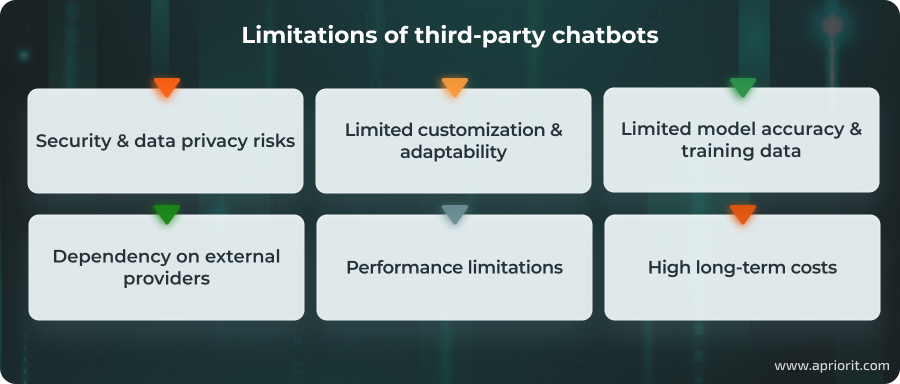
- Security and data privacy risks. Since ready-made and prompt-based chatbots operate on third-party servers, you have limited control over your data security. Sensitive information shared with the chatbot may be stored or used for further training unless there are strict opt-out policies.
- Limited customization and adaptability. While you can fine-tune responses via API configurations or prompts, or purchase add-ons, you can’t fully control the model’s behavior, logic, or workflow. This can lead to functional limitations, making it difficult to align a chatbot with your specific business processes or automation needs.
- Limited model accuracy and training data. Off-the-shelf AI models rely on general datasets and typically cannot be retrained on proprietary or industry-specific data. This will make your chatbot’s responses to domain-specific queries inaccurate or generic.
- Dependence on external providers. Any changes in your provider’s pricing, API limits, or availability can directly impact your chatbot’s performance and cost.
- Performance limitations. Ready-made and prompt-based chatbots depend on external infrastructure, which can lead to latency issues or service disruptions.
- Long-term costs. While off-the-shelf chatbots have lower upfront costs, they often require ongoing subscription fees, usage-based pricing, and extra charges for premium features.
Note: Some of these limitations can also be present in custom chatbots. For example, those that rely on external APIs can experience performance issues. However, with custom chatbots, you can mitigate those issues by caching frequent queries or building a hybrid architecture that uses various NLP components to cover certain types of requests. Generally, custom chatbots provide you with more tools to overcome limitations without relying on third-party companies.
With these limitations in mind, let’s discuss which businesses are likely to find off-the-shelf chatbots insufficient.
Read also
Top LLM Use Cases for Business: Real-Life Examples and Adoption Considerations
Find out how you can benefit from large language models and what to consider before adopting them.
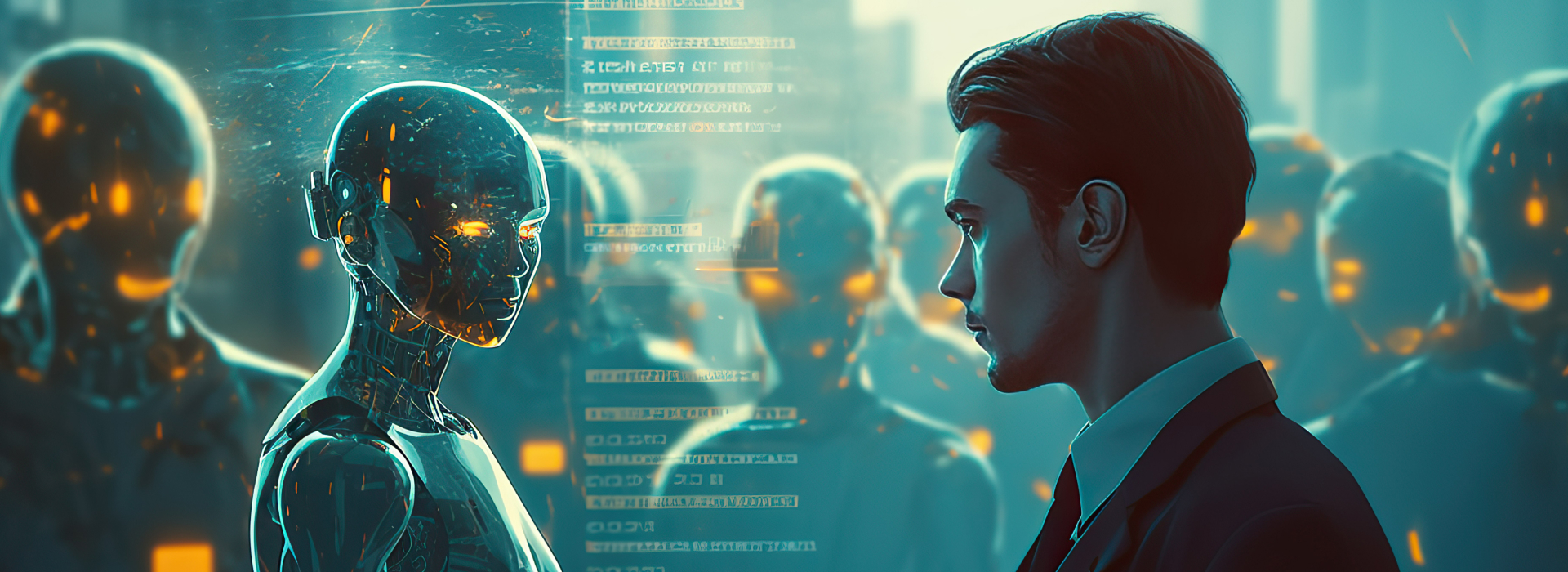
Who needs a custom chatbot?
You should consider building a custom chatbot instead of relying on off-the-shelf or prompt-based solutions if your business requires:
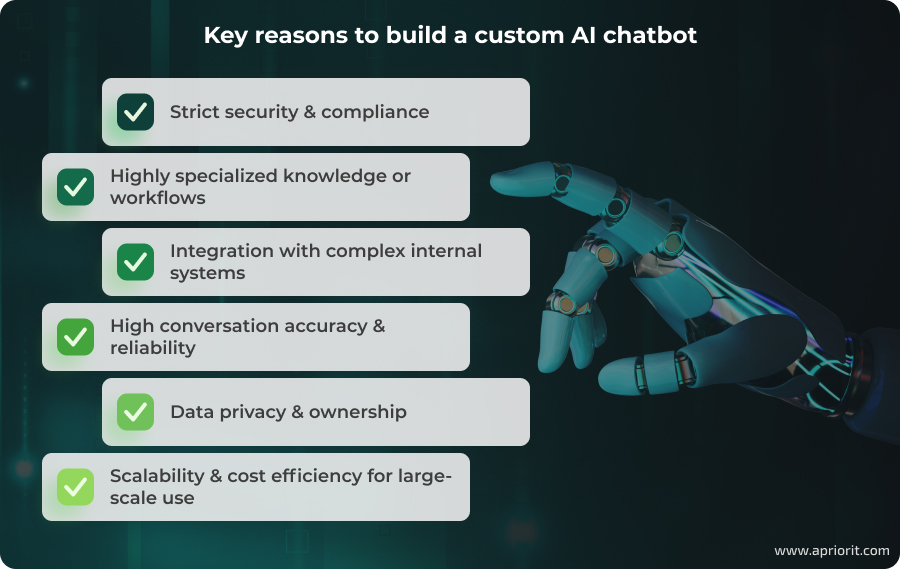
- Strict security and compliance. Highly regulated industries like healthcare, finance, and government must ensure data privacy, security, and compliance with laws and regulations (HIPAA, GDPR, SOC 2, etc.). A fully custom chatbot gives businesses control over data handling and storage.
- Highly specialized knowledge or workflows. If your business or your users require deep domain expertise (legal, medical, scientific, etc.), a custom chatbot trained on proprietary data can provide more accurate and relevant responses than a general-purpose chatbot.
- Integration with complex internal systems. If you need your chatbot to seamlessly connect with multiple internal databases, legacy software, or proprietary APIs, off-the-shelf solutions may be too rigid.
- High output accuracy and reliability. Some businesses need their chatbot to give precise responses based on strict guidelines. For example, if you want your chatbot to process insurance claims or assess credit requests for your customers automatically, you’ll need to fine-tune it on business-specific data.
- Data privacy and ownership. If your company requires full control over its data and doesn’t want to send sensitive information to a third-party provider, you can choose a self-hosted custom chatbot to ensure that all interactions remain private.
- Scalability and cost efficiency for large-scale use. If you expect your chatbot to be used extensively — for example, as part of your e-commerce or SaaS platform — fine-tuning and hosting a downloaded chatbot model can be more cost-effective in the long run than paying API fees.
Custom chatbots can meet these needs by offering unique benefits. Let’s take a closer look at them.
Benefits of custom chatbots for your business
By investing in your custom chatbot, you can get:
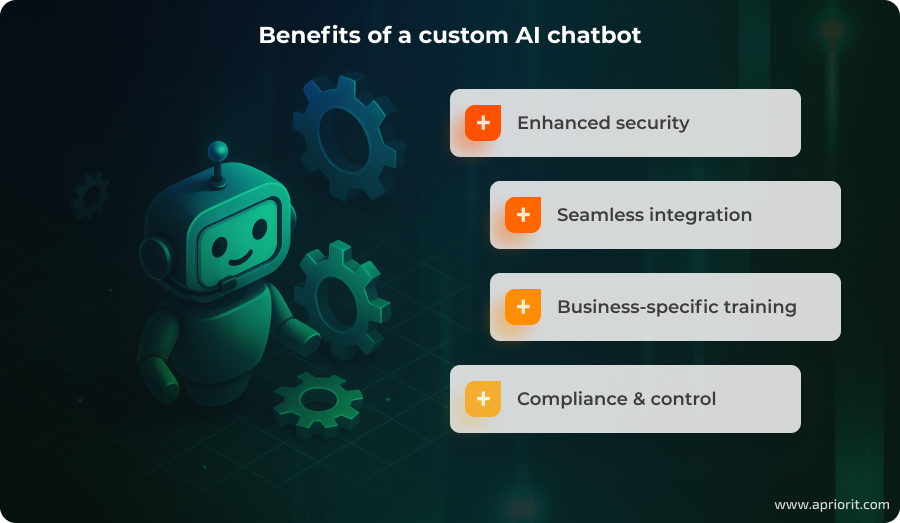
- Enhanced security. The chatbot can be hosted on-premises or within a private cloud, ensuring that sensitive business data never leaves a secure environment. But even if your chatbot relies on external APIs to process requests, you can still secure it on your end by adding data encryption, access control, etc.
- Business-specific training. The model can be fine-tuned on proprietary knowledge bases, customer service logs, or internal documentation to provide more accurate and relevant responses.
- Seamless integration. You can build a chatbot that will be compatible with your internal systems (CRM, ERP, databases) from the get-go so that it exchanges data in real time and works seamlessly as part of your ecosystem.
- Compliance and control. With a custom chatbot, you have full control over data storage, processing, and compliance.
To access these benefits, you need to carefully plan and build a chatbot that contains all the necessary features while also being secure, scalable, and reliable. This isn’t an easy task, and in the next section, we explain what makes chatbot development projects take time and effort.
Related project
Building AI Text Processing Modules for a Content Management Platform
Discover how the Apriorit team helped our client’s content management platform stay competitive by implementing AI modules that allowed end-users to translate, generate, and format text.

Why custom chatbot development takes so much time and expertise
Building a custom chatbot takes more time, experience, and money than simply getting an off-the-shelf chatbot or even customizing an LLM with prompts. But what exactly influences the final cost and timeline of a custom chatbot development project?
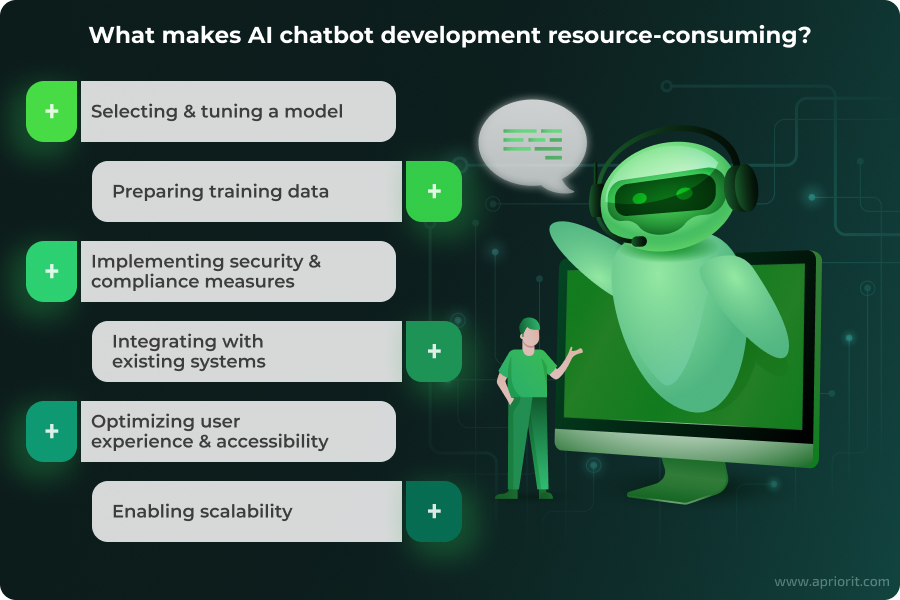
Let’s look at how to build a custom AI chatbot that will be able to execute your target tasks. We’ll cover all the necessary activities and explain why they take time and effort.
Selecting and tuning a model
Most custom chatbots use pretrained LLMs that serve as a starting point, as it’s simply not viable to build a custom LLM from scratch. But even with a pretrained LLM, it still takes time to choose the right model and optimize it for your specific use cases.
Developers must evaluate different LLMs (such as GPT-4, Claude, and open-source models like LLaMA) based on their alignment with your specific use case. Another important factor is your compliance needs. For example, businesses in some industries have very strict requirements concerning data privacy. If your business can only host data locally, you’ll need to use an LLM like LLaMA that can be downloaded to your environment and doesn’t need APIs to connect to third-party servers.
In addition, fine-tuning a model for specific tasks or industries requires well-organized training data, expertise, and computational resources, making this step both costly and time-consuming.
Preparing training data
High-quality data is essential for effective AI training, but acquiring and preparing it requires substantial effort. Businesses often lack structured data or don’t have enough of it, which makes gathering the necessary data and cleaning, formatting, and labeling custom datasets a significant challenge.
In cases where there’s not enough data, your chatbot development team must create synthetic datasets and apply data augmentation techniques to ensure the chatbot performs well in real-world scenarios.
Implementing security and compliance measures
Ensuring a chatbot meets industry-specific security and compliance requirements adds significant complexity. Developers must integrate encryption, secure authentication, access control mechanisms, and data anonymization features to protect sensitive information. Key regulatory considerations include:
- Data privacy and security – the GDPR if you handle data of EU residents, or the CCPA if you work with residents of California
- AI ethics – NIST AI Risk Management Framework, EU AI Act
- Cybersecurity and industry-specific requirements – SOC 2 for general cybersecurity, HIPAA for handling healthcare data in the US, PCI DSS for processing financial transactions globally
Unlike ready-made solutions, which handle security on the provider’s end, custom chatbots require a dedicated effort to stay compliant and secure.
Integrating with existing systems
While off-the-shelf chatbots work independently or come with pre-built integrations, custom AI chatbots must be designed to connect with internal databases, third-party APIs, and legacy software. This often requires developing custom middleware, ensuring data flows seamlessly between systems, and resolving compatibility issues.
Optimizing user experience and accessibility
Along with technical nuances, you also need to consider your chatbot’s usability. A user-friendly chatbot should be able to support a well-designed conversation flow, be accessible, and possibly support multiple languages or different types of input, such as voice.
Additionally, your chatbot should perform well across your target platforms, which can include websites, mobile apps, and voice assistants. Developing and maintaining these capabilities requires extensive effort.
Enabling scalability
Your custom chatbot must be able to efficiently handle increasing volumes of users and requests without lag or downtime. With a pre-built chatbot, your third-party provider scales automatically through cloud-based infrastructure. However, with a custom or self-hosted chatbot, you are responsible for load balancing, infrastructure planning, and performance optimization to ensure smooth scalability. Ensuring a chatbot can scale with business growth adds to the complexity and cost of development.
There are surely many things you need to plan and keep in focus to successfully build a custom AI chatbot. But with a professional team by your side, you can be sure that every aspect of chatbot development will be taken care of.
In the next section, you’ll learn what the typical AI chatbot development project looks like, from must-have features to the technology stack and required team.
Read also
How to Build a Context-Aware AI Chatbot: Development Challenges and Solutions from Apriorit Experts
Learn how to overcome the limitations of LLMs and improve their contextual awareness, memory retention, and behavior using Python and the Langchain library, and make your chatbot truly smart.

Key parts of an AI chatbot development project
The scope, team composition, and timeline of your AI chatbot development project will depend on the specific goals your business intends to achieve with the chatbot. While every project is unique, the following sections outline the typical features, team roles, and technologies involved in building a smart chatbot. Use this as a reference to understand what your project might require.
Let’s start with the features you need to build a smart AI chatbot.
AI chatbot architecture and key features
Typical AI chatbots have the following architecture, where each component is responsible for a certain feature set:
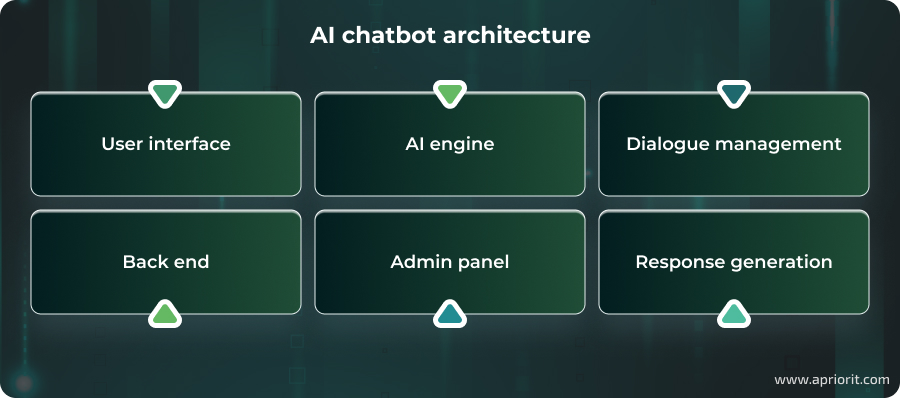
Note that the final list of features will be unique for every business and will depend on the tasks you need your chatbot to perform.
User interface
This is the user-facing part of your chatbot that manages all user interactions and ensures that your chatbot is easy to use across platforms.
Key features:
- Multi-turn conversation handling – Maintains context across multiple exchanges, enabling fluent, human-like interactions.
- Personalization – Adapts responses based on user preferences, previous interactions, and behavioral patterns.
- Omnichannel support – Ensures smooth interaction across web platforms, mobile applications, and messaging services.
- Multimodal support – Enables users to interact using not only text and voice but also images, video, or other media formats.
- Voice input/output support – Allows users to communicate with the chatbot using voice commands and receive spoken responses.
- Multilingual support – Supports multiple languages, making the chatbot accessible to a global audience.
AI engine
This is the core of your chatbot’s intelligence. It allows your chatbot to understand natural language, reason, and learn. The heart of this component is an LLM, which can be enhanced by training and fine-tuning using your custom data to increase its relevance and output accuracy.
Key features:
- LLM integration – Uses AI models like GPT-4, Claude, or open-source alternatives for advanced text generation and reasoning.
- Retrieval-augmented generation (RAG) – Enhances responses by pulling relevant information from external knowledge bases or documents.
- Adaptive learning – Continuously improves chatbot responses by analyzing past interactions and user feedback.
- Named entity recognition (NER) – Extracts specific information such as names, locations, and dates. While LLMs already handle this, businesses with structured data needs may require enhanced accuracy.
- Sentiment analysis – Identifies user emotions to tailor responses appropriately. Although LLMs infer tone, additional tuning can improve precision.
- Context memory extension – Expands the chatbot’s ability to retain and recall past conversations beyond the model’s built-in limitations, enabling long-term interactions.
Dialogue management
This component is responsible for controlling the conversation structure so that exchanges with your users are smooth. The behavior of your chatbot will depend either on the workflows you define for it or on user input.
Key features:
- Customizable conversation flows and automation rules – Allow you to define specific chatbot behavior, ensuring alignment with operational needs.
- Adaptive learning – Optimizes conversation patterns and improves chatbot performance based on real user interactions.
- Fact-checking module – Performs additional validation to verify AI-generated responses against trusted sources, reducing misinformation.
Back end
This is the home of your chatbot, meant to provide space, security, and stable work. It consists of the infrastructure for hosting your chatbot and enables it to securely connect to the external world. Here, your development team will add protections like secure authentication, access management, and encryption to ensure security and regulatory compliance.
Key features:
- Secure authentication and access control – Protects chatbot access through robust user verification and role-based permissions.
- Data encryption – Secures all chatbot interactions and stored data to prevent unauthorized access.
- Compliance – Ensures chatbot operations align with requirements like the GDPR and SOC 2.
- On-premises or private cloud hosting – Offers additional security options for businesses handling sensitive data.
- Input and output validation – Filters incoming messages and AI-generated responses to prevent harmful, offensive, or irrelevant content.
Admin panel
This component gives your administrators the tools to monitor chatbot performance, adjust workflows, and ensure high-quality user interactions. It is crucial for managing chatbot behavior, analyzing user engagement, and optimizing costs.
Key features:
- Analytics and reporting – Provides insights into chatbot performance, user engagement, and conversation effectiveness.
- Human handoff and issue escalation – Transfers conversations to human agents when AI responses are insufficient.
- Logging and auditing – Maintains detailed records of interactions for compliance and quality assurance.
- Conversation monitoring – Enables admins to review chatbot dialogues to ensure accuracy and quality.
- Cost tracking – Monitors API usage and processing costs to optimize chatbot expenses.
Response generation
This component handles how chatbot responses are created, ensuring they are accurate, contextually relevant, and aligned with business goals.
Key features:
- AI-driven text generation – Produces dynamic, human-like responses based on context and user inputs.
- Predefined and custom response templates – Allows businesses to configure structured replies for consistency.
- Integration with internal knowledge bases and APIs – Pulls data from enterprise systems to ensure chatbot responses are accurate and up to date.
This list of features may seem overwhelming, but note that you may not need all of them, especially if you decide to start with an MVP version of your chatbot. Your final feature set will depend on your unique requirements and the tasks you need to solve.
Let’s now look at the technologies that will allow you to implement your required functionality.
Read also
How to Develop Smart Chatbots Using Python: Examples of Developing AI- and ML-Driven Chatbots
Discover how to optimize your business with smart chatbots. Explore two ways of developing chatbots with Python tools.
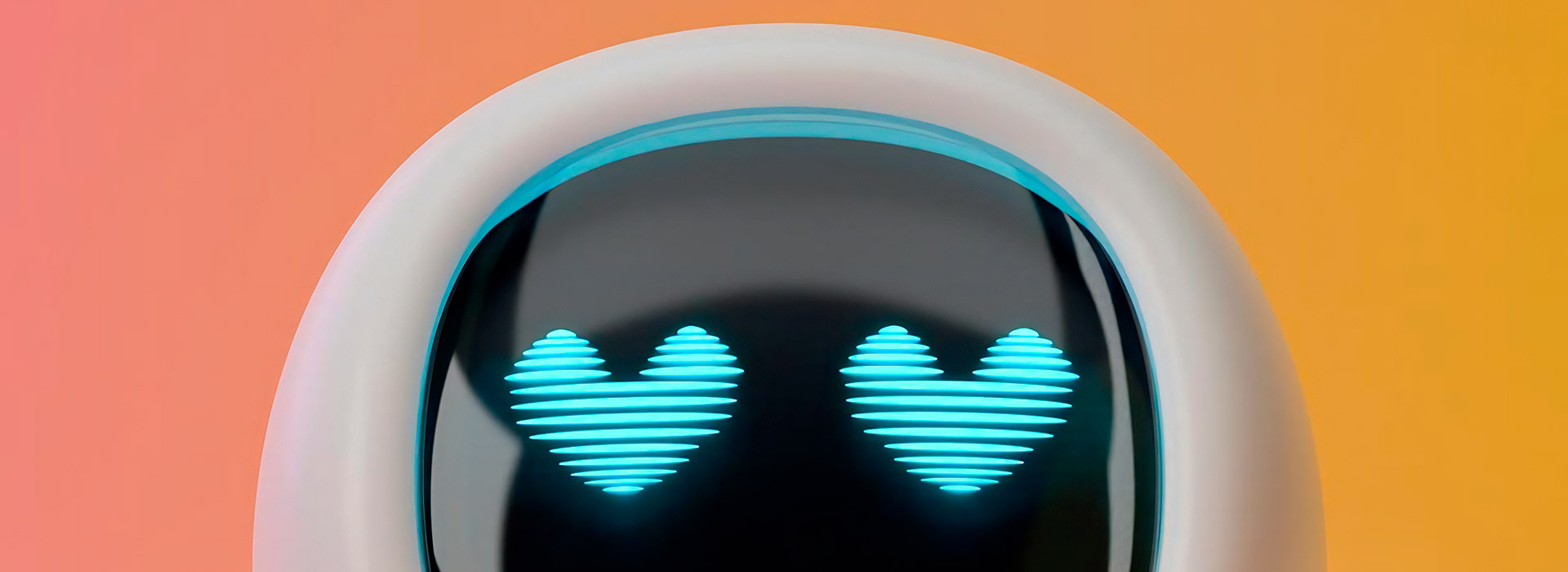
Custom AI chatbot tech stack
The technology stack for building a custom AI chatbot includes a combination of AI models, libraries, and frameworks to support both the front end and back end. Each component plays a crucial role in ensuring smooth interaction, high performance, and scalability.
At Apriorit, we take an individual approach to choosing technologies. Our experts adjust the final tech stack to specific chatbot requirements, but the typical tools we use in each category are the following:
Table 1: Custom AI chatbot tech stack
| Category | Technologies |
|---|---|
| AI models | OpenAI’s GPT-4, Google’s Bard (PaLM 2), Anthropic’s Claude, Cohere’s Command R |
| LLM libraries | LangChain, LiteLLM, LangGraph |
| RAG implementation | Vector databases (e.g., pgvector), R2R, RAG Fusion |
| Frontend frameworks | React.js, TypeScript, React JSON Schema Form, Redux Form |
| Chat UI components | React-Chat-Widget, BotUI |
| Backend frameworks | FastAPI, asyncio, Python |
| Backend testing frameworks | pytest, unittest |
| Database systems | PostgreSQL |
Let’s now look at the core team members that will help you select the right toolset and build your custom AI chatbot.
Team required for custom AI chatbot development
Developing a custom AI chatbot requires a skilled team with expertise in AI, software engineering, and project management. Each role contributes to different aspects of chatbot development, from architecture design to deployment and testing.
A typical AI chatbot development team consists of these specialists:
- AI/ML engineer – Prepares training datasets, integrates and fine-tunes AI models, implements NLP and RAG, and optimizes chatbot responses.
- Full-stack developer – Handles both frontend and backend development, ensuring smooth user interactions, seamless integrations with existing systems, and overall functionality. Your team can also have separate backend and frontend developers who handle their respective parts of the system.
- Business analyst – Defines chatbot requirements, aligns development with business requirements, and ensures the solution meets user needs. To create comprehensive project documentation, a BA performs market research, gathers stakeholder feedback, and translates business needs into technical specifications.
- DevOps engineer – Manages infrastructure, deployment, and automation processes, ensuring the chatbot runs efficiently. DevOps handles CI/CD pipelines, cloud configurations, and system monitoring.
- Project manager – Oversees the entire development process, ensuring the project stays on track, aligns with business objectives, and meets deadlines. They also manage communication between you and the development team.
- Software architect – Designs the overall chatbot architecture, selecting the appropriate technologies, frameworks, and infrastructure to ensure scalability, security, and efficiency.
- QA manager – Performs security assessments, performance testing, and quality assurance to ensure the chatbot functions reliably, securely, and efficiently.
This team configuration can be adjusted depending on the chatbot’s complexity and deadlines.
At Apriorit, we can provide you with any team configuration for chatbot development. For example, if you’d like to handle some parts of the process on your side, we can offer just the specialists you need to complete your team. Or, we can provide you with a fully dedicated team that will handle every part of the AI chatbot development process, from planning to maintenance.
Now, let’s see the approximate cost and time estimates for different types and stages of AI chatbot development.
Related project
Developing an Advanced AI Language Tutor for an Educational Service
Discover how the Apriorit team developed an interactive AI chatbot able to naturally converse with students while detecting and explaining mistakes, enhancing our client’s eLearning system.

Apriorit’s time and cost estimate for AI chatbot development
The duration and cost of your chatbot development project depend on many factors like complexity, availability of datasets for training, and team size. Below, you can see approximate estimates for a simple and complex AI chatbot.
When we say simple, we mean an AI chatbot that handles basic automation by retrieving and presenting relevant information from internal data sources. While it can understand and generate human-like text, its responses are limited to predefined knowledge.
A complex AI chatbot, on the other hand, is more advanced and can better understand context, handle natural conversations, and learn over time from interactions. It can integrate with multiple systems, supports complex workflows, and provides more accurate and dynamic responses tailored to users’ needs.
Table 2: Apriorit’s time and cost estimate for AI chatbot development
| Chatbot type | Development stage | Average duration | Average estimated budget | Output |
|---|---|---|---|---|
| Simple AI chatbot | Chatbot delivery | 2 months | $20,000 | – Integration with existing Data Management System – RAG and LLM integration – Voice input/output |
| Complex AI chatbot | PoC (Proof of Concept) | 2 months | $31,800 | – Initial validation of AI chatbot capabilities – Basic integrations and testing |
| MVP (Minimum Viable Product) | 4 months | $80,300 | – Extended functionality – More refined AI capabilities – Additional integrations | |
| Final product | 2 months | $26,800 | – Fully developed chatbot – Optimized performance and security – Deployment-ready |
While a simple chatbot will take approximately two months to develop, a complex, fully-fledged chatbot will take eight months of development time on average. You can accelerate the development by expanding your development team with extra engineers and data scientists.
At Apriorit, you will find a full range of specialists, team configurations, and pricing models to adjust the development process to your deadlines, business needs, and internal processes.
How Apriorit can help you create a custom AI chatbot
At Apriorit, we have real experience delivering powerful AI chatbot solutions for our clients. Our experts can help you choose the perfect technology for your needs, integrate it into your software, and complete a full spectrum of AI-related tasks, including:
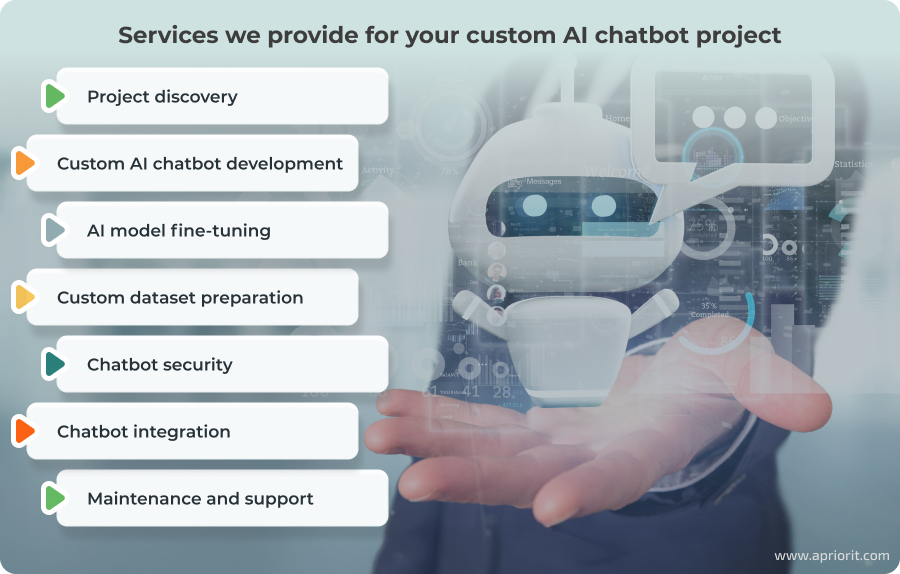
- Project discovery. If you’re not sure what direction to take and what kind of chatbot you need, our experts are here to help. We can gather your business requirements and provide you with a high-level roadmap to building a chatbot. As a result, you’ll get a clear picture of your chatbot’s timeline, cost, and required resources.
- Custom AI chatbot development. Our AI chatbot developers can build a comprehensive custom solution based on a ready model, handling all parts of the development process, from choosing the right technology set for your tasks and needs to delivering the final product with ongoing support.
- AI model fine-tuning. To ensure your chatbot performs specific business tasks effectively, you can fine-tune a pretrained AI model like GPT using your custom data. Our team can handle this process for you, employing advanced techniques such as hyperparameter optimization, transfer learning, and regularization to enhance the model’s accuracy, precision, and recall.
- Preparation of custom datasets. If you don’t have a ready dataset for training, we can help you collect, structure, and label your data to improve chatbot performance. If certain data is unavailable, we can also generate synthetic datasets to fill in the gaps.
- Securing your chatbot. To protect your chatbot from cybersecurity threats and ensure security-related regulatory compliance, you’ll need protection measures like encryption, access control, and data anonymization. Our team can handle this for you, conducting security assessments, adversarial testing, penetration testing, and vulnerability scans to safeguard your chatbot’s confidentiality, integrity, and availability.
- Chatbot integration. Your AI chatbot needs to be properly integrated into your infrastructure for it to work seamlessly within your existing workflows and systems. Our team can ensure smooth deployment, whether in a cloud-based or on-premises environment, while maintaining compatibility, scalability, and interoperability with your current technologies.
- Maintenance and support. To keep your chatbot accurate and aligned with new requirements, our team can handle ongoing fine-tuning, performance monitoring, and troubleshooting.
Conclusion
Although custom chatbots are more expensive and time-consuming to develop, they can address specific concerns and become powerful drivers of your business’s success.
At Apriorit, we recommend custom AI chatbots for businesses that handle sensitive data, operate in niche industries, require superior output accuracy, or plan to process large volumes of requests. To have these abilities, custom chatbots require thorough planning and design, high-quality training datasets, and a scalable, flexible architecture.
Apriorit’s AI chatbot development team can help you build, integrate, or fine-tune a custom AI chatbot so that its properties, functionality, and security perfectly align with your needs and industry requirements. Our data scientists can also help you prepare custom datasets to train the AI model for your chatbot so its output perfectly aligns with your internal processes and knowledge.
Looking for an expert AI development team?
Get a reliable partner in AI development who will implement the most suitable AI and ML models in your chatbot to make it efficient, secure, and precise.


